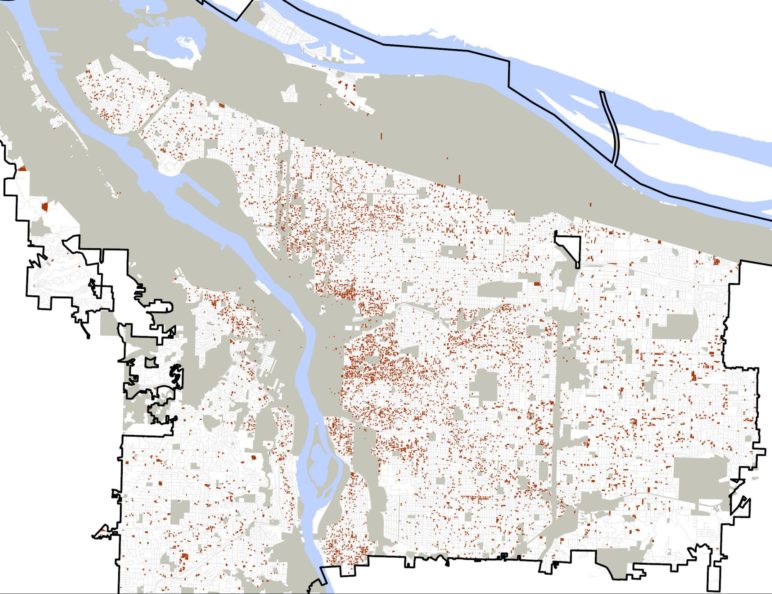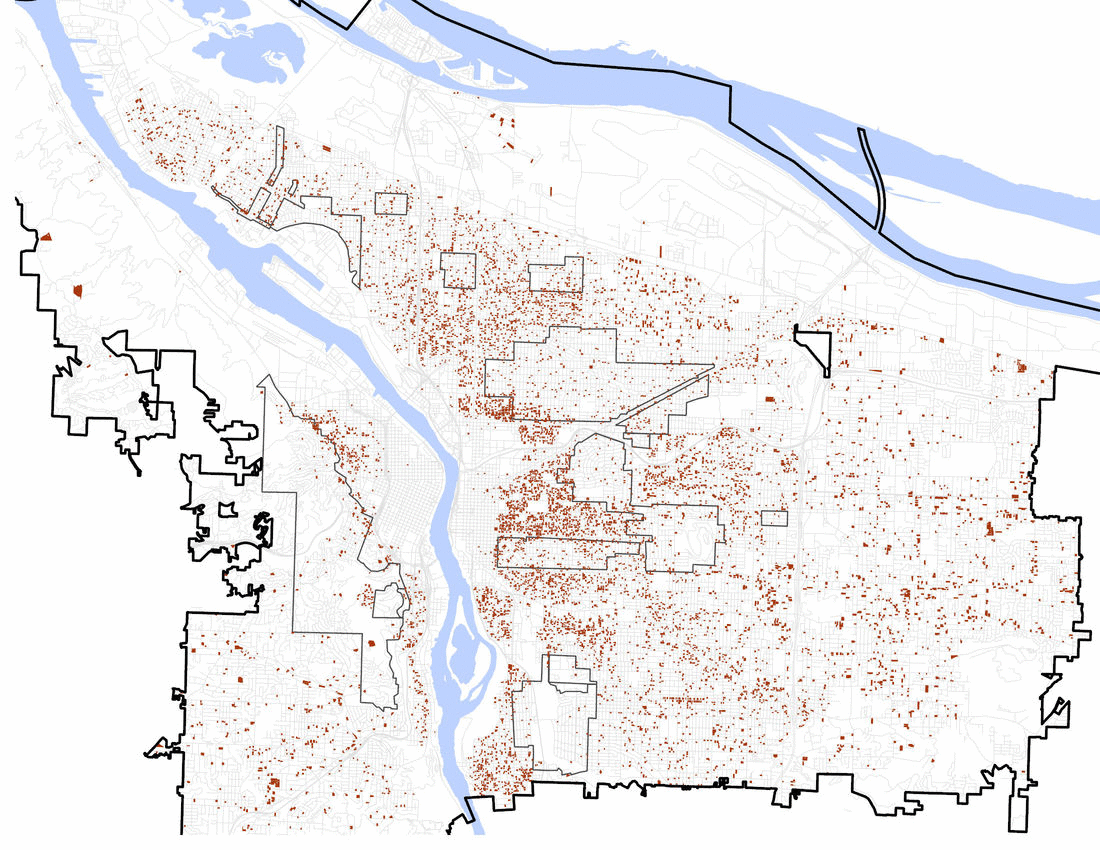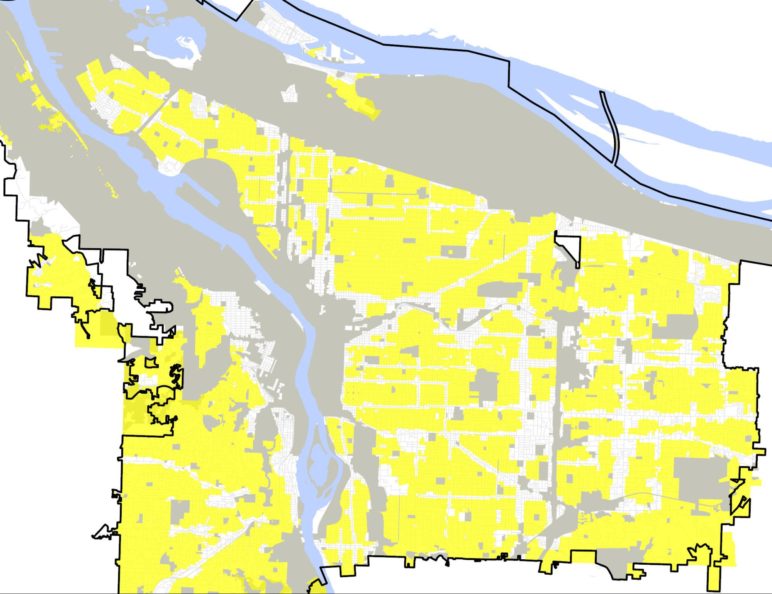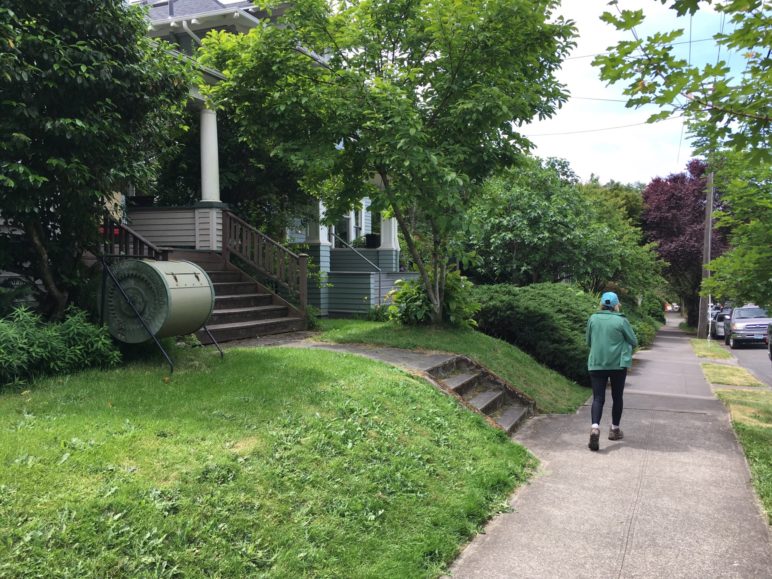A new set of maps created by Neil Heller reveal a surprisingly dark pattern—and show it’s still shaping how the economic, social and natural wealth of our cities gets distributed.
Many Pacific Northwesterners know that duplexes, triplexes and other “gentle density” housing remain common in older parts of our cities even though they’re usually illegal to build today.
Less discussed is the fact that even in cities where building small detached homes used to be common, some of our older neighborhoods have few such housing options.
A new set of maps created by Portland housing-options advocate Neil Heller reveal some of this surprisingly dark history—and show it’s still shaping how the economic, social and natural wealth of our cities gets distributed.
Here’s a map of Portland with industrial, parkland and high-density areas grayed out. Each red dot is a building that includes between two and eight homes: a duplex, triplex, fourplex, or small apartment building.
“Gentle density” housing is clustered in Certain Portland neighborhoods.

As we’d expect, these sorts of homes are clustered in older neighborhoods near the city center — but not in all the older neighborhoods.
Within the city’s vast expanses of residential neighborhoods, several areas almost seem airbrushed out. Red dots of duplexes, fourplexes and garden apartments surround them; within them, few dots appear.
I asked Neil if he could draw boxes around a few of these duplex deserts.
Some Portland neighborhoods have Many fewer small-scale housing options.

If you’re familiar with Portland, you might know these areas by name: the West Hills, Irvington, Alameda, Laurelhurst, Eastmoreland, Mount Tabor, Arbor Lodge.
What’s the deal?
The answer lies in 1924—the year Portlanders passed their first housing ban.
Portland’s first exclusionary zoning
It was in 1924 that Portland voters approved the city’s first zoning plan in a citywide vote, four years after having narrowly rejected the idea.
It was a turbulent moment in Oregon politics. In 1922, the resurgent Ku Klux Klan had swept to electoral victory across the state, putting its members in the governor’s mansion, the House speakership, and controlling the Multnomah County Commission. In 1923, the Klan-backed Alien Land Bill, banning Japanese nationals from owning property in Oregon, sailed through the Klansman-led state legislature with just one dissenting vote.
A parallel national movement was afoot. A White House task force convened in 1921 was pushing US cities to pass zoning codes. The task force’s official documents never mentioned race, but its members were “outspoken segregationists” who (as documented by Richard Rothstein) wrote elsewhere that zoning could help segregate people by race.
This was the political environment when Portland’s real estate brokers brought a revised zoning plan back to voters for another try. Authored by H.E. Plummer, who served as a planning commissioner and head of the city’s bureau of buildings, the 1924 plan was approved with 60 percent of the vote, and formally separated industrial and residential development. And it introduced another idea, too: “single-family” zoning, which required households who wanted to live in certain parts of town to be able to pay not only for a home but for a certain minimum amount of land around it—at least 5,000 square feet in most cases. Other sorts of homes would be banned.
Who decided where the housing ban would apply? According to Lloyd Keefe’s history of Portland zoning, the city tried to refer the decision to “a majority of property owners” in each area by creating single-family zones whenever a petition or community club requested one.
Portland’s first 15 single-family zones, from which attached homes were banned at the request of property owners of the day, are featured in the map below.
Portland banned attached homes from 15 neighborhoods between 1924 and 1959.

Look familiar?
OK, I cheated. For the previous map, I didn’t really ask Neil to outline the areas without many dots—I just asked him to drop in the outlines of these zones from 1924. That’s because the correlation is striking. You can see the ban’s effects on every street in most of these areas today—94 years later, they have very little variety of housing at all. It’s one lawn and driveway after another.
A few duplexes, triplexes and small apartment buildings have sneaked into these areas since 1924, thanks to loopholes or upzones along major streets. But it’s nothing like the change outside their borders.
The impact of Portland’s 1924 zoning plan remains apparent to this day.

Then in 1959—incidentally, 11 years after the US Supreme Court declared “racial covenants,” race-restrictive clauses in housing deeds, “unenforceable”—Portland tried something even bigger. It expanded its ban on attached housing to almost every neighborhood. The map below displays where the ban applies today.
Portland expanded its ban on attached housing to cover most of the city.

Today, this is more than just a matter of how neighborhoods look. Ninety-four years after the 1924 ban on attached homes, Portland’s first single-family zones are clearly visible in neighborhood income levels.
Highlighted in blue in the map below is every Census block group in Portland with a median income over $60,000 (darker blue blocks have median incomes over $95,000).
There is a striking correlation between Portland’s zoning and median incomes.

Again, the similarity is striking. There are a few ways for a neighborhood in the Portland of 2018 to be reserved mostly for the well-off. But one of the most effective ways seems to be “ban attached housing in 1924.”
Portland’s first exclusionary zones and high-income areas overlap.

It turns out that when you make it illegal for someone to live in an area without also paying for an entire city lot of land, the only people who can live in that area are the richer ones.
Does this exclusion persist because Portland homeowners sympathize with the Klan? Of course not.
Here’s how it works: The classist and possibly racist impulses that convinced a majority of Portland voters to start banning certain types of housing in the 1920s carved patterns of segregation into city laws and, eventually, into unconscious assumptions about what is and isn’t normal in a city. Indeed, I bet almost all of us Cascadians now unconsciously assume it’s normal for large swaths of a city to have nothing except detached homes surrounded by yards.
You don’t have to be racist or classist to live in a neighborhood shaped by racism and classism.
But whoever you are and whatever neighborhood you live in, your life is still being shaped by the ways these forces shaped your neighborhood.
Portland may partially reverse its 1924 and 1959 mistakes
As we’ve been reporting, Portland (like Minneapolis) is currently considering an end to this ban on duplexes and other gentle density citywide—not only in the parts of the city where attached housing was legal until 1959, but also in the parts of the city that have almost no attached homes because they were banned in 1924.
Among those backing this re-legalization at the planning commission this month were some Portlanders whose ancestors, if they’d lived in Oregon, would have been forbidden to own property.
One was Danell Norby of Anti-Displacement PDX. She spoke on behalf of her part of town, East Portland. Re-legalizing small attached housing there, she said, would both allow “outer areas the density needed to support additional amenities” and give nonprofit developers more tools for preventing displacement.
“These policies will help determine whether or not Portland’s spoken commitment to racial and economic diversity is actualized,” Norby said. “The current proposal blocks the development of badly needed, comparatively affordable infill housing even as market forces displace families from these neighborhoods to Gresham, Vancouver, Washington County, and beyond.”
And Chris Chen, currently a homeowner in the Eastmoreland neighborhood, spoke on behalf of his own personal history — how he’d built his life as a young Portlander by living in the sort of small, attached homes that the city started banning in 1924.
“Over 10 years ago I moved into my first Portland home, a courtyard studio apartment on Northwest 20th Avenue,” he said. “Later I moved to a garden apartment by Balch Creek, and then to a four-plex where I watched the Chapman Swifts from my living room window. And every breakfast featured the sounds of families walking their kids to school. The irony of this Portland story is that the structures I used to call home are illegal to build today.”
Chen said Portland has a chance to “deliver transformative justice by re-legalizing and providing diverse housing choices for a diverse population — and in so doing, begin to reverse a century of exclusionary policy.”
As clearly as Heller’s maps, Norby and Chen’s testimony showed why zoning maps are moral issues, shaping local lives for generations to come.
But by mentioning the benefits of gently denser neighborhoods, Norby and Chen also highlighted what Portlanders, like all Cascadians, have to gain by re-legalizing small attached homes everywhere.
In the end, it’s the difference between requiring neighborhoods to look like this:

And making it legal for them to eventually look more like this:

For most Cascadians, is this really a difficult choice?


Comments are closed.